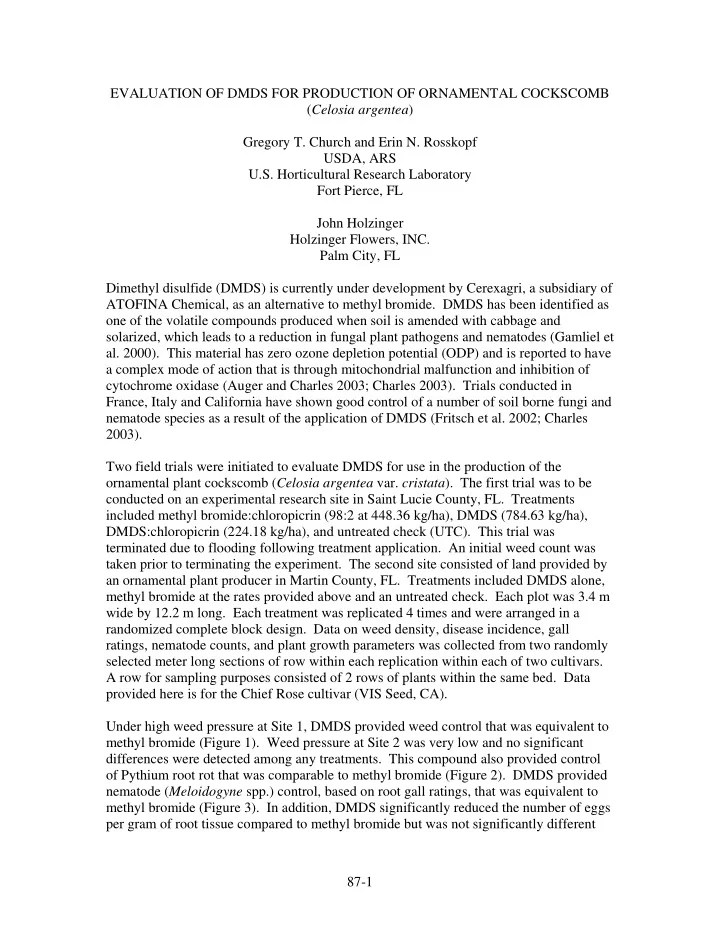

EVALUATION OF DMDS FOR PRODUCTION OF ORNAMENTAL COCKSCOMB ( Celosia argentea ) Gregory T. Church and Erin N. Rosskopf USDA, ARS U.S. Horticultural Research Laboratory Fort Pierce, FL John Holzinger Holzinger Flowers, INC. Palm City, FL Dimethyl disulfide (DMDS) is currently under development by Cerexagri, a subsidiary of ATOFINA Chemical, as an alternative to methyl bromide. DMDS has been identified as one of the volatile compounds produced when soil is amended with cabbage and solarized, which leads to a reduction in fungal plant pathogens and nematodes (Gamliel et al. 2000). This material has zero ozone depletion potential (ODP) and is reported to have a complex mode of action that is through mitochondrial malfunction and inhibition of cytochrome oxidase (Auger and Charles 2003; Charles 2003). Trials conducted in France, Italy and California have shown good control of a number of soil borne fungi and nematode species as a result of the application of DMDS (Fritsch et al. 2002; Charles 2003). Two field trials were initiated to evaluate DMDS for use in the production of the ornamental plant cockscomb ( Celosia argentea var. cristata ). The first trial was to be conducted on an experimental research site in Saint Lucie County, FL. Treatments included methyl bromide:chloropicrin (98:2 at 448.36 kg/ha), DMDS (784.63 kg/ha), DMDS:chloropicrin (224.18 kg/ha), and untreated check (UTC). This trial was terminated due to flooding following treatment application. An initial weed count was taken prior to terminating the experiment. The second site consisted of land provided by an ornamental plant producer in Martin County, FL. Treatments included DMDS alone, methyl bromide at the rates provided above and an untreated check. Each plot was 3.4 m wide by 12.2 m long. Each treatment was replicated 4 times and were arranged in a randomized complete block design. Data on weed density, disease incidence, gall ratings, nematode counts, and plant growth parameters was collected from two randomly selected meter long sections of row within each replication within each of two cultivars. A row for sampling purposes consisted of 2 rows of plants within the same bed. Data provided here is for the Chief Rose cultivar (VIS Seed, CA). Under high weed pressure at Site 1, DMDS provided weed control that was equivalent to methyl bromide (Figure 1). Weed pressure at Site 2 was very low and no significant differences were detected among any treatments. This compound also provided control of Pythium root rot that was comparable to methyl bromide (Figure 2). DMDS provided nematode ( Meloidogyne spp.) control, based on root gall ratings, that was equivalent to methyl bromide (Figure 3). In addition, DMDS significantly reduced the number of eggs per gram of root tissue compared to methyl bromide but was not significantly different 87-1
than the untreated check. DMDS significantly reduced the population of root knot juveniles in the soil to a level that was comparable to methyl bromide. Most importantly, although the DMDS did seem to impact vegetative growth of cockscomb (Figure 4), marketable yields from this treatment were equivalent to that resulting from the use of methyl bromide (Figure 5). These preliminary findings justify continuation of the evaluation of DMDS as a replacement for methyl bromide in cut flowers. Total Weeds-Site 1* A 200 # weeds/ 0.25 m 150 100 B 50 B B 0 UTC DMDS DMDS+pic MeBr Treatment Figure 1. Total weed counts per 0.25 meter at Site 1, Saint Lucie County, FL. *Weed counts performed at 4 and 8 weeks after treatment. Data presented is 8 weeks after treatment. Bars with the same letter are not significantly different according to LSD (0.05). 87-2
Root Health* A 1.6 1.4 1.2 rating (0-4) 1 0.8 B 0.6 B 0.4 0.2 0 UTC DMDS MeBr Treatment Figure 2. Root health rating (*scale 0-4: 0=healthy, 1=1-25% root necrosis, 2=26-50% root necrosis, 3=51-75% root necrosis, 4=76-100% root necrosis). Bars with the same letter are not significantly different according to LSD (0.05). Gall Rating* A 2.5 2 B rating (0-5) 1.5 B 1 0.5 0 UTC DMDS MeBr Treatment Figure 3. Gall rating (*scale 0-5: 0=no galling, 1=trace infection with few small galls, 2=<25% roots galled, 3=25-50%, 4=51-75%, and 5=>75% galling). Bars with the same letter are not significantly different according to LSD (0.05). 87-3
Plant Height B 124 122 120 A cm 118 A 116 114 112 UTC DMDS MeBr Treatment Figure 4. Cockscomb plant height (cm). Bars with the same letter are not significantly different according to LSD (0.05). Harvest cuts A marketable cuts 30 A A 25 20 # Stems b b 15 a 10 5 0 UTC DMDS MeBr Treatment Figure 5. Plant harvest data. Cuts represents the total number of flowers in each meter of row. Marketable cuts represents the number of these flowers that are saleable according to the grower’s standard. 87-4
Acknowledgments The authors wish to acknowledge the assistance of Tony Estes, Cerexagri, Steve Godbehere and Phil Crumpacker, Hendrix and Dale. References Auger, J. and Charles, P. 2003. Biogenic emission, biological origin, and mode of action of DMDS, a natural, ubiquitous fumigant. Annual International Research Conference on Methyl Bromide Alternatives and Emissions Reductions. Pp. 138. Charles, P. 2003. DMDS: anew alternative for soil disinfestations. Annual International Research Conference on Methyl Bromide Alternatives and Emissions Reductions. Pp. 23.1-23.4. Fritsch, J. Baudry, A, and Aubert, T. 2002. Dimethyl disulfide as a new potential alternative to methyl bromide for soil disinfestations. Proceedings of the International Conference on Alternatives to Methyl Bromide, Seville, Spain. P. 340. Gamliel, A, Austerweil, M., and Kritzman, G. 2000. Non-chemical approach to soilborne pest management-organic amendments. Crop Protection 19:847-853. 87-5
Recommend
More recommend